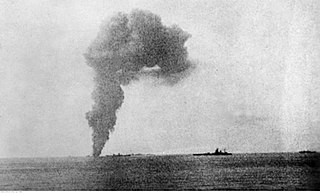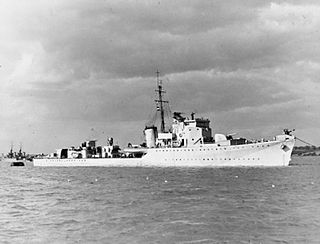
Force H was a British naval formation during the Second World War. It was formed in late-June 1940, to replace French naval power in the western Mediterranean removed by the French armistice with Nazi Germany. The force occupied an odd place within the naval chain of command. Normal British practice was to have naval stations and fleets around the world, whose commanders reported to the First Sea Lord via a flag officer. Force H was based at Gibraltar but there was already a flag officer at the base, Flag Officer Commanding, North Atlantic. The commanding officer of Force H did not report to this Flag Officer but directly to the First Sea Lord, Admiral of the Fleet Sir Dudley Pound.

HMS Indomitable was a modified Illustrious-class aircraft carrier built for the Royal Navy during World War II. Originally planned to be the fourth of the class, she was redesigned to enable her to operate more aircraft, 48 instead of 36. A second hangar was added above the original, raising the flight deck by 14 feet (4.3 m), although the hangar-side armour had to be reduced to compensate. The lower hangar was made shorter than the upper hangar due to the need for extra workshops and accommodation to support the added aircraft.

HMS Argus was a British aircraft carrier that served in the Royal Navy from 1918 to 1944. She was converted from an ocean liner that was under construction when the First World War began and became the first example of the standard pattern of aircraft carrier, with a full-length flight deck that allowed wheeled aircraft to take off and land. After commissioning, the ship was involved for several years in the development of the optimum design for other aircraft carriers. Argus also evaluated various types of arresting gear, general procedures needed to operate a number of aircraft in concert and fleet tactics. The ship was too top-heavy as originally built, and had to be modified to improve her stability in the mid-1920s. She spent one brief deployment on the China Station in the late 1920s before being placed in reserve for budgetary reasons.

The siege of Malta in World War II was a military campaign in the Mediterranean Theatre. From June 1940 to November 1942, the fight for the control of the strategically important island of the British Crown Colony of Malta pitted the air and naval forces of Fascist Italy and Nazi Germany against the Royal Air Force (RAF) and the Royal Navy.

The Battle of the Mediterranean was the name given to the naval campaign fought in the Mediterranean Sea during World War II, from 10 June 1940 to 2 May 1945.

The Malta convoys were Allied supply convoys of the Second World War. The convoys took place during the Siege of Malta in the Mediterranean Theatre. Malta was a base from which British sea and air forces could attack ships carrying supplies from Europe to Italian Libya. Britain fought the Western Desert Campaign against Axis armies in North Africa to keep the Suez Canal and to control Middle Eastern oil. The strategic value of Malta was so great the British risked many merchant vessels and warships to supply the island and the Axis made determined efforts to neutralise the island as an offensive base.

Operation Substance was a British naval operation in July 1941 during the Second World War to escort convoy GM 1, the first of the series from Gibraltar to Malta. The convoy defended by Force H was attacked by Italian submarines, aircraft, and Motoscafo armato silurante.

HMS Laforey was an L-class destroyer of the Royal Navy. She was commissioned in and served during the Second World War, and was torpedoed and sunk by a U-boat in 1944. She had been adopted by the civil community of Northampton in November 1941.

807 Naval Air Squadron was a Naval Air Squadron of the Royal Navy.

Club Run was an informal name for aircraft ferry operations from Gibraltar to Malta during the Siege of Malta in the Second World War. Malta was half-way between Gibraltar to Alexandria and had the only harbour controlled by the British in the area. Malta had docks, repair facilities, reserves and stores, which had been built up since the cession of the island to Britain in 1814. Malta had become an important staging post for aircraft and a base for air reconnaissance over the central Mediterranean. The Axis powers Italy and Germany made several attempts from 1941 to 1942 to either force the British military authorities on the island to surrender or to destroy its effectiveness as a military base. The island was a forward base from which Axis supplies to their North African armies could be attacked. It is a measure of Malta's importance that Britain reassigned fighter aircraft from home defence.

Operation Calendar in 1942 was an Anglo-American operation in World War II to deliver Supermarine Spitfire fighter aircraft to Malta. The aircraft were desperately needed to bolster the island's defence against strong Axis air raids.

Operation Bowery was an Anglo-American operation in World War II to deliver Spitfire fighter aircraft to Malta. The aircraft were desperately needed to bolster the island's defence against strong Axis air raids.

The second HMS Hambledon was a Hunt-class destroyer of the Royal Navy in commission from 1940 to 1945. She was a member of the first subgroup of the class, and saw service throughout World War II.
HMS Blencathra (L24) was a Hunt-class destroyer of the Royal Navy in commission from 1940 to 1948. She was a member of the first subgroup of the class, and saw service through most of World War II.

The second HMS Exmoor (L08), ex-HMS Burton, was a Hunt-class destroyer of the Royal Navy in commission from 1941 to 1945. She was a member of the second subgroup of the class, and saw service during much of World War II. She later served in the Royal Danish Navy as HDMS Valdemar Sejr.

HMS Wishart (D67) was a Modified W-class destroyer of the British Royal Navy that saw service in World War II. She spent most of her wartime career based at Gibraltar, engaged in convoy defence, but also served in various naval and military operations in the Mediterranean Sea.

885 Naval Air Squadron was a Naval Air Squadron of the Royal Navy's Fleet Air Arm. First formed on 1 March 1941, the squadron served as a fighter squadron during the Second World War. It operated in the Mediterranean in 1942–43, where it took part in Operation Torch, the Anglo-American invasion of French North Africa, the Allied invasion of Sicily and the Allied invasion of Italy. In 1944 it took part in the Allied invasion of Normandy, spotting for Allied artillery bombardments and in 1945, was deployed as part of the British Pacific Fleet. It was abolished for the last time on 27 September 1945.
World War II was the first war where naval aviation took a major part in the hostilities. Aircraft carriers were used from the start of the war in Europe looking for German merchant raiders and escorting convoys. Offensive operations began with the Norwegian campaign where British carriers supported the fighting on land.
This page is based on this
Wikipedia article Text is available under the
CC BY-SA 4.0 license; additional terms may apply.
Images, videos and audio are available under their respective licenses.


 — invasion of Yugoslavia.
— invasion of Yugoslavia.  — response to Italian defection. Final plan Achse represented combination of plan Schwartz and original plan Achse.
— response to Italian defection. Final plan Achse represented combination of plan Schwartz and original plan Achse.
 — Afrika Korps advance into Egypt.
— Afrika Korps advance into Egypt. —failed operation to fly agents into Morocco
—failed operation to fly agents into Morocco
 — German intelligence activity around Gibraltar
— German intelligence activity around Gibraltar
 — Axis attack toward El Alamein that became the Battle of Alam el Halfa
— Axis attack toward El Alamein that became the Battle of Alam el Halfa 
 — counter-attack at Medenine, Tunisia
— counter-attack at Medenine, Tunisia  —aborted attempt to establish assault bases along Algerian-Tunisian border
—aborted attempt to establish assault bases along Algerian-Tunisian border
 — planned invasion of Gibraltar.
— planned invasion of Gibraltar.
 — attack on CCA/1st at Sidi bou Zid.
— attack on CCA/1st at Sidi bou Zid. — rejected proposal to withdraw troops in Italy behind the Po River.
— rejected proposal to withdraw troops in Italy behind the Po River. — planned Axis airborne invasion of Malta.
— planned Axis airborne invasion of Malta. — plans for operations on the Iberian peninsula.
— plans for operations on the Iberian peninsula.  — amended Isabella.
— amended Isabella. —Isabella renamed.
—Isabella renamed. — third and final plan in case of Allied landings in the Iberian peninsula.
— third and final plan in case of Allied landings in the Iberian peninsula. — evacuation of Sicily following Allied Operation Husky.
— evacuation of Sicily following Allied Operation Husky. — invasion of Greece.
— invasion of Greece.  (1941) — planned German intervention in Albania
(1941) — planned German intervention in Albania  — German invasion of Crete
— German invasion of Crete  — reinforcement of Regia Aeronautica in Mediterranean by X Fliegerkorps
— reinforcement of Regia Aeronautica in Mediterranean by X Fliegerkorps  — occupation of Gafsa
— occupation of Gafsa  — German counterattack against Allied Operation Shingle.
— German counterattack against Allied Operation Shingle.
 — refuelling of U-boats by Spain
— refuelling of U-boats by Spain —
—
 — anti-Partisan operation
— anti-Partisan operation
 — Axis recapture of Halfaya Pass
— Axis recapture of Halfaya Pass 
 —
— — movement Afrika Korps troops to North Africa as a result of Compass
— movement Afrika Korps troops to North Africa as a result of Compass —
—
 — offensive to drive Allies out of Cyrenaica and Egypt
— offensive to drive Allies out of Cyrenaica and Egypt 
 — axis offensive against the American 92nd Infantry Division in the Apennines
— axis offensive against the American 92nd Infantry Division in the Apennines 
 — axis attack on the Gazala Line
— axis attack on the Gazala Line 













